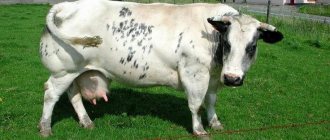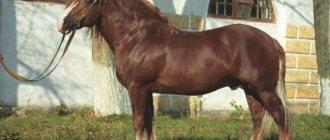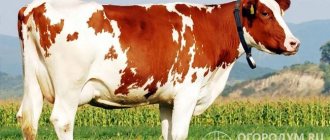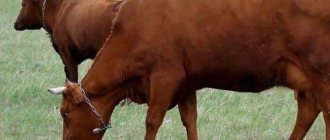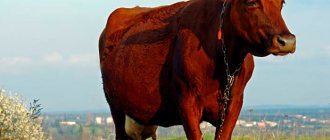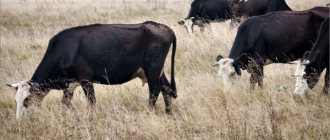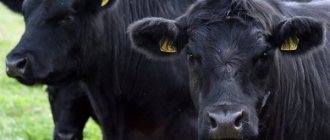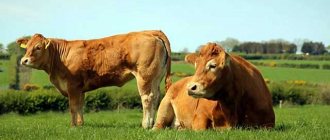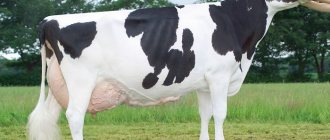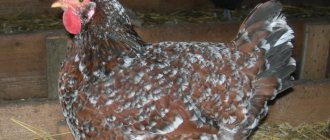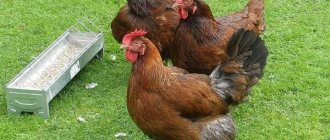Origin story
The first mention of the Schwyz breed of cows dates back to the distant 14th century. The mountain canton of Schwyz - this region of Switzerland is directly related to this breed, because it was bred there by crossing local cows with eastern individuals. This had a specific goal - to breed an animal from which it would be possible to obtain a lot of milk and meat. In those days, another characteristic was given a lot of attention - the cow had to have working qualities. Therefore, only the strongest and healthiest individuals with the best productivity were used for crossing.
The goal was achieved, the new breed turned out to be highly productive in all areas: early maturing, with an excellent physique. Selection work does not stop to this day. In particular, there are now two subspecies within the Schwyz breed: valley cows and mountain cows. Both varieties have some distinctive features, and this goes towards improving the breed.
Description of the Swiss cow
Exterior
The Swiss cow can come in a variety of colors, from light to dark gray. The muzzle, hooves and hair at the end of the tail (switches) are black. This breed of cattle is known for strong legs and feet and "general structural correctness", which means high productivity and long lactation.
Height at the withers is about 130 cm, body length is 1.8 m. The average weight of cows is 0.5 tons, bulls are 0.9-1.1 tons.
The characteristics of the species say that the Swiss breed of cows is obedient and calm, so it is often used as an exhibition animal. However, bulls are treated with caution as they are strong animals with a highly developed instinct for self-defense.
Nutrition
The daily diet of Swiss cows includes high-quality and nutritious food. Animals need more greens than grains. In the summer months there is enough food on pastures. During the winter months, feed the animals hay as well as silage. Silage – tops, castings, plant stems, which are prepared by fermentation.
Livestock require plenty of clean, fresh drinking water every day. Give your Swiss breed water at least 2 times a day.
Distribution area
Initially, the Swiss breed was present only in the historical region, but over time such individuals began to appear in Italy, Germany, and Austria. Such animals also came to America, but much later, in the 20th century. Naturally, due to being in other countries, the breed underwent some modifications, because individuals had to be crossed with the breeds that predominated there. Thus, in Italy, the Swiss cow has a larger meat yield, while in Germany and Austria, individuals, on the contrary, are smaller in size.
This breed has not spared Russia either. Here it appeared for the first time in the 19th century. First, adult individuals—bulls and heifers—were imported, and they were crossed both with each other and with local stock. As a result of this selection, the Brown Swiss breed was developed into three different subspecies: dairy, meat and milk-meat.
The bulls were distinguished by their breeding qualities, so they were specially kept at breeding stations and were used everywhere to improve the breed of local livestock. The Swiss breed became widespread in Russia in the Smolensk province and the Moscow region. The greatest spread of the breed was noted in 1925 after the breed was included in the State Book of Breeding Animals. Today, the most commonly grown breed is the all-purpose, dairy and meat Swiss breed. Approximately 2% of the total cattle population in Russia are Swiss cows.
Cow productivity
The Swiss cow is the second type in terms of the amount of milk produced after the Holstein. Schwyz cattle produce about 21 liters of milk per day.
In animals, quantity and quality of the product are combined. Swiss milk is valued worldwide due to its fat content of about 4% and protein content of 3.5 to 3.8%.
Quality indicators of Swiss dairy products in countries in 2021:
| A country | Fat, % | Protein, % |
| Austria | 4,13 | 3,50 |
| France | 4,20 | 3,62 |
| Germany | 4,22 | 3,62 |
| Italy | 4,05 | 3,59 |
| Slovenia | 4,18 | 3,47 |
| Switzerland | 4,03 | 3,42 |
Animal milk is the direct raw material for cheese production. When producing cheese, the milk quality indicator is taken into account. It is defined as the ratio of fat to protein and should be greater than or equal to 1.15. With a coefficient of 1.22, the Swiss breed is one of the three world leaders.
The University of Parma, in Italy, has highlighted differences in milk composition between dairy cattle in favor of Swiss cattle:
- Phosphorus content + 8% and calcium + 7%, compared to Holshin.
- Low content of chloride ions.
- Casein kappa: 70%. Thanks to this content of Kappa Casein BB, the cheese yield increases by 2-3 times.
Characteristics
As already mentioned, in each country the Swiss breed has received some of its own changes, but the generally accepted standards include:
- Brown color, a variety of shades possible. A light stripe can be seen along the ridge. As a rule, bulls are more intensely colored, the head and front part of the body are dark.
- The body of such animals is proportionally built - it is stocky and strong, the legs are straight and not too long. The neck is not too long, but muscular, the head is small and neat with a wide forehead.
- Animals have thin and elastic skin.
- Another characteristic feature is that around the nose there is a lead-colored rim and a fringe of small hairs.
- Bulls are quite tall compared to cows of other breeds, they reach 150 cm at the withers, while the body length reaches 170 cm.
- A Swiss dairy cow can be distinguished by its more elongated body and flat ribs, fragile skeleton, rounded belly and large udder.
- The milk-meat direction is characterized by developed muscles. The udder in this case is much smaller and has a bowl shape.
- The meat type of this breed has loose muscles, convex powerful breasts and an underdeveloped udder.
Characteristics of the Montbeliarde breed of cows
In addition to Swedish cows, the Montbéliarde breed is especially in demand among home farmers. Such cattle belong to the elite group, and the total number of animals worldwide reaches 1.5 million individuals. About 383 thousand animals are concentrated in France alone. This popularity is explained by its excellent adaptation to various weather conditions and unpretentious behavior. Animals quickly adapt to the harsh climate and heat and are not afraid to consume large volumes of roughage.
The animals are distinguished by their rather large size and proportional build. The length of the body reaches 1.62 meters, the head is very large and the chest is deep
Bulls have an extended dewlap, a broad back and strong bones, which is important for keeping in problematic conditions. Montbéliarde milk contains a large amount of milk fat and protein, and the cows have a long lactation period. The meat of this breed is considered high quality and is in worldwide demand.
In one year, an adult cow produces about 8,000 kilograms of milk with a fat content of up to 4 percent and a protein content of 3.45%
The meat of this breed is considered high quality and is in worldwide demand. In one year, an adult cow produces about 8,000 kilograms of milk with a fat content of up to 4 percent and a protein content of 3.45%.
Productivity
The productivity of a given breed and its universal variety is determined in the following areas:
- Weight gain is an important indicator. Calves of this breed are capable of gaining 1 kg per day with proper care. At the same time, they are born large and weigh 35-40 kg. If all maintenance recommendations are fully followed, then by the end of the first year of life the calf will weigh about 250 kg, and at 1.5 years 370 kg.
- Adult weight. Animals of this breed are large. For example, a cow can weigh up to 800 kg, a bull up to 1000 kg. The yield of meat at slaughter depends on the type of breed and the fatness of the animal and is 50-60%.
- Milk yield. On average, cows of this breed produce 3-3.5 tons of milk during the lactation period, its fat content ranges from 3.6-3.8%. In good breeding farms, with an abundant, balanced diet, a cow can produce up to 5 tons of milk. Record holders are known to produce up to 12 tons of milk per year. The milk of such cows is so highly valued that it is widely used in cheese making.
Reproduction and calving
The first pregnancy usually occurs at the age of 1.8 years in females and about the same in males. Sometimes the indicator for mating is the weight of a Swiss heifer - it should reach 380 kg, and one individual can produce up to 18 calves in its lifetime.
Swiss heifers intended for breeding are separated from the rest a week before mating. Calves are quite large and develop quickly: they weigh 37–42 kg and, with proper nutrition, gain 1 kg per day. Due to the large size of the fetus, Swiss cats need obstetric assistance; they cannot do it themselves. One of the complications during the lactation period is mastitis, which develops due to the inability of the udder to feed. In general, calving occurs without pathologies.
For the first 7 days, newborns live with their mother. During this period, they are fed with oats and bran for speedy recovery and proper development. There is little milk at this time, so the nutrition of the young requires special attention, and the calving individual is milked 5–6 times a day. With proper nutrition and care, Swiss calves quickly gain weight: by the time they are one year old, the animals already reach 260–300 kg.
Advantages and disadvantages
The breed, which emerged as a result of complex breeding work, has many advantages. These include:
- Easy acclimatization and endurance. Short-term stress or not too long a stay in unfavorable conditions will not affect the productivity of individuals, nor their general well-being.
- Immunity, which allows individuals to resist many diseases inherent in cattle.
- Good-natured, friendly, calm disposition. Moreover, the kindness of these cows is manifested both in relation to people and to their relatives. However, there is a clear hierarchy in the Swiss herd. A leader is chosen once and remains so forever. The direction in which the herd will move depends on the leader.
- Early ripening and high reproductive qualities. The probability of stillbirth of calves is minimal.
- The fat content of milk, which makes it suitable for making cheeses and butter. The fat content of the milk fully compensates for the not very large milk yields from these cows.
- Accelerated growth and muscle mass gain.
Of course, speaking about the advantages, we must not forget about the disadvantages:
- Milking is not easy, milk output is up to 1.2 kg per minute. This is a feature of all Swiss cows, which makes machine milking almost impossible, because... The devices are designed for a higher rate of milk release.
- Picky eating. Individuals of this breed will not eat musty and stale food. In addition, it is sometimes recommended to alternate feeds, creating some variety. This increases productivity.
- Inability to use individual cows for machine milking. This is due to the fact that the udders of heifers are often incorrectly formed and they can only be milked by hand.
Maintenance and care of the Swiss breed
There are two ways to care for bulls and heifers of this breed of cattle.
- Stall. Can be used for farms with calves. There should be a supply of food in the stall throughout the year. In winter it consumes silage and beetroot. In the warm season - grass and bran.
- Pasture-stall. With the onset of cold weather, the cattle are moved to a stall. During the summer season, cows are grazed on pasture, where they can enjoy an unlimited amount of lush grass.
The main thing a farmer should know about Swiss dogs is normal nutrition.
The diet of livestock must include: grass and vegetables. The products obtained as a result of nutrition will directly depend on this. In addition, alfalfa and clover have a negative effect on cows. For this reason, in Switzerland they try to keep cows in a stall with the necessary supply of feed. The Schwyz breed is bred in group and individual ways . As a rule, the bull is assigned to the heifer. They are selected for breeding according to their characteristics and characteristics. Heifers are selected from the age of one and a half years. The calf and its mother live together for the first week, and then are moved out.
Calves require no less meticulous care than adult animals. Every day they are fed with an oat mixture, which helps strengthen the immunity of the future milk and meat producer.
Diet
In order for the young to fully develop, and for the adult to produce as much milk as possible, a complete, balanced diet is necessary and important. It should contain good hay, silage, root vegetables, bran (they are needed in winter).
In the summer, cows make do with pasture grass, but not every pasture is suitable. It should have good, juicy grass. For this purpose, clover, vetch, peas and alfalfa are specially sown. Then, closer to autumn, the same grass is mowed and hay is prepared. Steppe pastures with stunted vegetation are not suitable for Swiss cows.
Important! Cows of this breed are fastidious. Therefore, they need to be fed abundantly and variedly. Their health and milk quality directly depend on this. In any case, the basis of the diet is hay, root vegetables and bran.
The optimal feeding scheme in the morning and evening is water, hay, compound feed, and in the afternoon - hay and water.
Maintenance and nutrition
Weight gain and milk yield depend on living conditions, so optimizing housing and nutrition is a very important point. Females and bulls are bred using a purely stall method (without taking them outside) and a combined stall-pasture method. The first of them is suitable for farming, the second for private owners.
Meadows with perennial plants are prepared for summer pasture. It is very important to monitor the composition of the vegetation: for example, when eating wormwood, the milk acquires a bitter tint.
During the cold season, animals are kept in a spacious, ventilated barn, illuminated by both electric and daylight. You can walk them in winter: this improves immunity and reduces the risk of infectious diseases. For winter walking, it is recommended to place a sheaf of hay on the site so that natural roughage is available to the cow during the walk.
To make winter maintenance comfortable, the barn needs to be regularly changed and cleaned. In an ideal room for keeping Schwitz, the temperature is 5–15 degrees Celsius, humidity is 60–70%; air circulates at a speed of 0.5 m/s, ammonia concentration does not exceed 20 mg/sq. m, and carbon dioxide - 0.25%. A photo of a Swiss cow in a barn will help to complete the idea of good living conditions.
In summer, fresh grass is enough for animals, so the owner’s responsibilities include only providing access to a walking area and water. The winter diet consists of hay and concentrates (silage, corn, mixed feed) with the addition of fresh grass (clover, peas, alfalfa) and root vegetables, which increase the taste of milk. In winter, the mineral balance of cows and bulls is maintained with salt and bone meal. It is recommended to distribute food according to the daily schedule as follows:
| Morning | Hay, combined feed | Water |
| Day | Hay | |
| Evening | Hay, combined feed |
Content
Basic methods of keeping Swiss cows:
- Stall. It is ideal on those farms where calves are kept and the necessary supply of a variety of feeds is available all year round.
- Pasture-stall. This is the main method for private households. It turns out that feed needs to be prepared only for the winter. In the warm season, cows are grazed on pastures.
A warm, ventilated room plays an important role in the normal development of cows. It is also necessary to take care of free space for each cow. Ideally, this should be a room of about 2-4 m2, with high ceilings. You also need to count on the fact that for the first time after calving, the calf will also be kept on a suckling calf.
Cows and bulls of the Swiss breed have an impressive weight, so attention should be paid to the floor in the barn, which must be durable. It is important that the cow's hooves do not slip on it. This is fraught with various injuries. It is necessary to provide natural lighting in cow buildings. Cleaning and replacing bedding is the basis of cattle care. Cows are periodically brushed. The udder requires hygiene - it is washed with soap and water before each milking. In order to prevent the formation of cracks in the udder, it is lubricated with special compounds after milking.
Peculiarities of Schwitz breeding
Female Schwyzes are fertile, and bulls are considered good producers. There are 2 methods of breeding animals of this breed:
- The standard method is based on traditional group content.
- In individual breeding, each cow is assigned a bull. Animals are selected with the desired characteristics, with the goal of obtaining offspring with certain qualities.
After calving, females become very weak and require special care and good attention. The feeding diet includes mixtures of bran and oats. Feed is given in portions up to 10 times a day, milking immediately after calving is carried out up to 6 times a day.
Health
As already mentioned, this breed has strong immunity. Regular sanitary treatment of barns is sufficient to eliminate the incidence of disease in the herd. Weekly cleaning of the premises, feeders, drinking bowls with special disinfectant solutions or boiling water reduces the likelihood of diseases to nothing. Treatment is important before the resettlement of young animals, because calves do not yet have such strong immunity as adults. For preventive purposes, you need to monitor the cleanliness of animal fur. Pathogenic microorganisms that cause various diseases easily and quickly develop in dirty wool.
Due to frequent milking, cows sometimes develop mastitis, and it is also provoked by increased feeding. When a cow becomes very fat, her bones become thinner and joint problems appear, so calcium and table salt supplements must be constantly present in the diet.
Important! Vaccination is carried out annually, which minimizes the likelihood of infectious diseases. Regular checkups are also necessary.
Content Features
The Schwyz breed of cows is known for its fastidiousness in terms of keeping conditions at home and feeding standards. They require the construction of a barn in accordance with all existing standards - the presence of a sewerage system, a heating system, and ventilation. Otherwise, animals lose productivity and often get sick. For this breed, the pasture method of keeping is preferable - free-range cows produce more milk. For home breeding, the pasture-stall method is more suitable. Read about tethered housing of cows here.
The basis of the feeding ration should be roughage and succulent feed of the highest quality; partial use of mixed feed is acceptable. Females should be offered a mixture of oats and bran during calving and nursing to speed up the recovery process. It is recommended to change the diet periodically, as Swiss cows often demonstrate pickiness in choosing food. To improve the quality of milk, a large amount of succulent feed is required, for which it is best to use alfalfa, peas and clover. Read about cow feeders in this article.
The Schwyz cow can be kept in
stalls or pastures.
Breeding
It is recommended to select cows for breeding starting from 8-10 months. After the onset of pregnancy, heifers can be kept in a general herd, but must be removed a week before calving. We accept both natural and artificial fertilization processes. Read about cow breeding as a business in this material.
Calves are born large, up to 40 kg, and then slowly gain weight . By the age of one year, cows can weigh up to 250 kg, and by 18 months - up to 380 kg. Newborn calves should be kept in a warm room with their mother, and their well-being should be regularly monitored. Females have good maternal instinct, which simplifies the maintenance process. Find out more about feeding dairy cows here.
Calves from Swiss cows weigh about 40 kg at the time of birth.
Care
The Schwyz cow needs a spacious paddock. One animal requires at least 2.3 m2, with a ceiling height of at least 2.2 meters. It is recommended to make the flooring especially durable, since representatives of this breed are heavy. The surface should not slip, for which it is advisable to use rubber mats. It is important to organize access to natural light. This link will tell you about ventilation in the barn.
The barn should be cleaned daily and disinfected at least twice a week. Animals should be washed and brushed regularly with a stiff brush. In addition, heifers' udders should be washed before milking.
During the period when cows are constantly in the stall, they are fed concentrated feed and hay.
The udders of Swiss cows often crack and burst due to regular milking. To avoid this, you should abandon automatic milking machines and regularly lubricate your animals' teats.
Diseases
Swiss cows have good health and a well-formed constitution. Mastitis is most often observed in animals, since the udder is not adapted to frequent milking and feeding during calving. In addition, due to high weight, problems with the joints of the limbs may occur, so you should regularly include calcium and salt in your diet.
Like other representatives of cattle, they need routine vaccination against deadly diseases. When keeping large livestock, veterinary examinations should be carried out at least 3 times a year.
Breeding
In order to select females for offspring, young heifers begin to be looked at from the age of 1.5 years. An animal older than 9 months is suitable for mating. After mating, the cows are kept with the entire herd. Insemination occurs naturally or artificially (the latter is considered effective).
About 2 weeks before calving, the animal is moved to a separate room - warm, dry and draft-free, with plenty of bedding. Sometimes cows require obstetrics because... Calves are born quite large, which makes calving very difficult. After calving, it is important to avoid mastitis. When calves are born, they need to be monitored, they should always be warm. In addition to the milk that is given to the calf, it needs to be fed oat-bran mixtures. You can give this mixture to a cow so that she recovers as quickly as possible after giving birth.
After calving, she needs rest and proper nutrition; vitamin supplements are added to the feed. Swiss cows have a strong maternal instinct. They feed the calf and care for it. Calves are often separated from cows so as not to disrupt the milking schedule. Then they are fed milk manually, sometimes adding vitamin supplements. Adult feed is introduced gradually, observing the well-being of the calf.
Newborn calves have their horns burned off at a very early age. This is done so that when they grow up they do not hurt each other. This technique also allows you to contain a larger number of individuals in a small area.
Schwyz cows live up to approximately 20 years. Old cows (over 15 years of age) are slaughtered as soon as they stop lactating. At this age, you can no longer expect offspring from such a cow, so keeping it becomes unprofitable.
In order to obtain healthy and purebred offspring, only the best representatives of the breed, productive and possessing all the necessary characteristics, must be selected for the tribe. During her life, one cow can give birth to up to 18 calves.
Pros and cons of the Swiss breed of cows
Pros of the type:
- Productivity. As already mentioned, the Swiss cow is one of the most productive cows in the world, second only to the Holstein. Animals produce up to 9000 kg of milk per lactation!
- Milk quality. The cow's milk is of excellent quality and is mainly used to make cheese. It contains a large amount of fat as well as protein. Milk is unique among other breeds as it has longer chains of fatty acids.
- Less care and food. Animals are hardy by nature because of their past. This means that cows require less care than other breeds and much less feed.
- Strong. These cattle have powerful, strong hooves and legs. They have fewer problems with lameness than other dairy breeds.
- Swiss cows produce milk for up to 15 years.
- Adaptable. Thanks to its "Alpine heritage", the Swiss breed is able to live in most climates. Cows cope with cold temperatures and have excellent foraging instincts. This means that the animals survive on most types of pasture.
- Temperament. Schwitzes are docile in nature and are often described as “gentle giants.”
- Early maturation. Heifers reach sexual maturity at 18 months of age, while bulls are ready to mate at 16-18 months.
- Beef. The meat is valued due to the presence of a large amount of muscle and the rapid growth of bulls.
- Health. Cows are highly resistant to disease.
Disadvantages of the type:
- Long pregnancy period.
- The productivity of an animal depends on nutrition.
- Due to the structure of the udder, heifers can be difficult to milk.
Prospects
The total number of cattle in Russia is about 19 million heads, the number of Swiss cows is only about 1000 individuals. It is noticeable that this breed is not popular, which is due to the whimsical nature of the animals and lack of productivity. This also includes difficulties in care and problems with breeding. Breeders of such cows note that the high adaptability of individuals to climate and weather can compensate for some of the shortcomings of the breed. Regardless of whether the region is cold, wet or hot and dry, Swiss cows will take root anywhere. Swiss cows can also live in mountainous areas.
According to farmers, Swiss cows have a good return on investment. This is due to their good health, excellent adaptation, and the ability to graze the herd on any terrain without negative consequences for the hooves. Even high mountain areas where there is lush grass are suitable for pastures. Experienced breeders also note that if a cow does not like the food, she may refuse it. The fact that during the warm season most of the time the herd grazes on meadows allows saving on feed.
Characteristics of the Montbeliarde breed of cows
In addition to Swedish cows, the Montbéliarde breed is especially in demand among home farmers. Such cattle belong to the elite group, and the total number of animals worldwide reaches 1.5 million individuals. About 383 thousand animals are concentrated in France alone. This popularity is explained by its excellent adaptation to various weather conditions and unpretentious behavior. Animals quickly adapt to the harsh climate and heat and are not afraid to consume large volumes of roughage.
The animals are distinguished by their rather large size and proportional build. The length of the body reaches 1.62 meters, the head is very large and the chest is deep
Bulls have an extended dewlap, a broad back and strong bones, which is important for keeping in problematic conditions. Montbéliarde milk contains a large amount of milk fat and protein, and the cows have a long lactation period. The meat of this breed is considered high quality and is in worldwide demand.
In one year, an adult cow produces about 8,000 kilograms of milk with a fat content of up to 4 percent and a protein content of 3.45%
The meat of this breed is considered high quality and is in worldwide demand. In one year, an adult cow produces about 8,000 kilograms of milk with a fat content of up to 4 percent and a protein content of 3.45%.
Purchase
The cost of cows of this breed can reach 50 thousand rubles. The final cost depends on the age, productivity and characteristics of the breed. For breeding, it is recommended to purchase young heifers at the age of 7-8 months. If you have a goal to buy a purebred Swiss calf, then you need to read the documents. It is necessary to study the external characteristics of the animal and determine whether its appearance matches the description of the breed. A veterinary certificate must be presented upon purchase. It indicates the health of the individual.
Origin
The Schwyz breed of cows was developed in Switzerland. The first mentions of it were found in the records of the servants of the Benedictine monastery in the Schwyz area, who were actively involved in keeping and breeding cattle. The monks paid great attention to productivity and feeding ration, so these factors directly affected the appearance and performance of the cows. Initially, the emphasis was on the ability to perform all kinds of agricultural work, but later the main purpose of breeding became the production of meat and milk. The first stud book for this breed was opened in 1879; the cattle in it were very different from their ancestors both in appearance and in the direction of productivity.
Today, the Schwyz breed is widespread throughout the world . Large populations have been recorded in 64 countries. It is actively bred in Europe, North America, Australia and New Zealand. The first representatives of this breed of cattle came to Russia only in 1861.
The homeland of the Swiss breed of cows and bulls is distant Switzerland.
In Russia in the 19th century, only landowners could afford the Schwyz breed of cows, since they required expensive feeding and care.
Animal health
There are no genetically determined hereditary diseases in the breed, and in general, Swiss cattle are in good health. But under poor housing conditions, cows can suffer from infectious diseases, their metabolism is upset, and productivity deteriorates. If you raise animals correctly, this does not happen.
Changing the place of residence does not affect the health of the Swiss. They easily adapt when transported to another location without experiencing stress. This is especially true for young animals.
Disadvantages and advantages compared to other breeds
Jersey cow breed
The main advantages of these animals:
- high resistance to diseases, strong immunity;
- precocity of young animals;
- disposition - calm, balanced;
- good acclimatization in different climatic zones;
- well-developed reproductive function in cows.
Schwitz offspring
Swiss dogs pass all their positive qualities on to their offspring, which is why they are actively used in breeding new breeds of cattle.
The obvious disadvantages of these cows include:
- cows require certain conditions of keeping and feeding;
- In some cows, the shape of the udder may be irregular, with teats placed close to each other, so it is difficult to use artificial milking machines;
- Mechanized milking can be difficult due to the low milk yield rate of cows.
Distinctive features of the breed
A general description of animals of this species begins with the fact that all individuals differ in the proportionality of their body. Externally, the Swiss breed can be distinguished by the following characteristics:
- strong skeletal structure;
- large body size;
- medium height;
- correct limbs;
- elastic skin;
- brown color.
It is important for breeders to know that some animal parameters depend on the breed variety. There are three of them in total: meat and dairy - characterized by smaller dimensions and a poorly developed udder, dairy and meat - the most harmonious of their fellow tribesmen, and dairy - distinguished by a stretched body and less developed muscles.
Breeding and general care rules
Representatives of the Swiss breed can be kept both in stalls and in the stall-pasture method. When keeping these cattle year-round in barns, the farmer must constantly have a supply of various feeds, including grains, silage, hay and green mass, as well as various vegetables.
Kholmogory breed of cows
On private farmsteads, with the arrival of spring, farmers drive their cows out to pasture, thereby saving feed. Ideally, there are meadows nearby on which perennial grasses are sown specifically for grazing these domestic animals.
Important! The main feature of Swiss cows is the direct dependence of productivity on quality feed. Therefore, the owner of this livestock must create a diet so that it contains all the necessary fats, proteins and carbohydrates. The menu should include green mass (mainly clover, alfalfa, vetch, peas), vegetables.
Sample menu for an adult cow:
- breakfast - mixed feed, hay, water in sufficient quantity;
- lunch - hay, water;
- dinner is the same as breakfast.
How much hay and feed to give depends on the age of the individual, the main criterion is not to overfeed.
In the summer, when grazing, animals are given only water, since they consume a sufficient amount of green mass while grazing.
Prospects for cultivation
The efforts of breeders are aimed at improving the breed and reducing their shortcomings. First of all, work is underway to increase the milk flow rate. Breeders set themselves the task of increasing the milk yield rate to 2 liters per minute. For this purpose, individuals with the correct udder shape are allowed for breeding. The breeding stock uses Swiss bulls of American selection. The heifers obtained from these bulls are distinguished by a pronounced body type, characteristic of dairy breeds.
The Schwyz breed of cows is considered promising for raising on a private farmstead. When using manual milking, you can ignore the structure of the udder and get a sufficient amount of milk. The cost of a high-pedigree heifer is quite high - up to 1 thousand dollars, but the purchase is justified by the high productivity of the breed.
Schwyz cows are smart and calm. They produce tasty and nutritious milk. These qualities make breeding the breed quite promising.
Before reading the reviews, we suggest watching a program dedicated to the Schwyz breed of cows.
